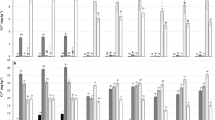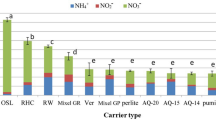Abstract
IN work concerning the decomposition of antibiotics in soil and micro-organisms capable of this process, a chloramphenicol solution (250 µgm. chloramphenicol/gm. soil) was percolated through 25-gm. sieved fresh garden soil, PH 7.5, in an apparatus similar to that described by Lees and Quastel1. The chloramphenicol was applied in three doses; the first dissolved in 50 ml. sterile distilled water and the others in 5 ml. added to the percolate in the reservoir. The antibiotic was bioassayed daily against Bacillus subtilis. The first dose disappeared after 11 days and the second and third after 3 days.
This is a preview of subscription content, access via your institution
Access options
Subscribe to this journal
Receive 51 print issues and online access
$199.00 per year
only $3.90 per issue
Buy this article
- Purchase on Springer Link
- Instant access to full article PDF
Prices may be subject to local taxes which are calculated during checkout
Similar content being viewed by others
References
Lees, H., and Quastel, J. H., Biochem. J., 40, 803 (1946).
Pridham, T. G., Hesseltine, C. W., and Benedict, R. G., App. Microbiol., 6, 52 (1958).
Waksman, S. A., Bact. Rev., 21, 1 (1957).
Author information
Authors and Affiliations
Rights and permissions
About this article
Cite this article
ABD-EL-MALEK, Y., MONIB, M. & HAZEM, A. Chloramphenicol, a Simultaneous Carbon and Nitrogen Source for a Streptomyes sp. from Egyptian Soil. Nature 189, 775–776 (1961). https://doi.org/10.1038/189775a0
Issue Date:
DOI: https://doi.org/10.1038/189775a0
This article is cited by
-
Shared strategies for β-lactam catabolism in the soil microbiome
Nature Chemical Biology (2018)
-
Antibiotics as food for bacteria
Nature Microbiology (2018)
-
FMNH2-dependent monooxygenases initiate catabolism of sulfonamides in Microbacterium sp. strain BR1 subsisting on sulfonamide antibiotics
Scientific Reports (2017)
-
Call of the wild: antibiotic resistance genes in natural environments
Nature Reviews Microbiology (2010)
Comments
By submitting a comment you agree to abide by our Terms and Community Guidelines. If you find something abusive or that does not comply with our terms or guidelines please flag it as inappropriate.



